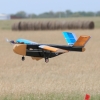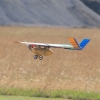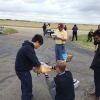UCI Design/Build/Fly Team Takes Third
 April 29, 2016 - UC Irvine’s Design/Build/Fly team placed third out of 80 in the AIAA Foundation annual competition held this year in Wichita, Kansas. About 650 students representing 68 colleges on four continents took part in the three-day event, April 15-17, held at Textron Aviation.
April 29, 2016 - UC Irvine’s Design/Build/Fly team placed third out of 80 in the AIAA Foundation annual competition held this year in Wichita, Kansas. About 650 students representing 68 colleges on four continents took part in the three-day event, April 15-17, held at Textron Aviation.
A partnership between the AIAA Foundation, Cessna Aircraft Company and Raytheon Missile Systems, the annual DBF competition provides students an opportunity to design and build an unmanned, electric-powered, radio-controlled aircraft to perform specific missions. Participants who complete a letter of intent and submit a report on time are invited to bring their plane to a central location for a flyoff. Winners are determined by a combination of their report and flight mission scores.
It was the 20th year of the competition and the challenge was one of the more difficult in the contest’s history. It required students to build two radio-controlled airplanes: a small production aircraft (PA) that could carry the payload of a one-liter bottle of Gatorade, and a second larger manufacturing aircraft (MA) that could transport the subassembly parts of the first plane. These requirements emulated today’s real world distributed manufacturing of aircraft, in which components are transported by air before assembly.
UCI’s 34-member team designed a mid-size, 56-inch wing span, manufacturing plane. The MA was large enough to carry the smaller plane without disassembling it as well as handle the notorious wind they were expecting in Wichita. “Wind was a big obstacle – 15 mph winds gusting up to 23 mph -- but we anticipated it because we had been there before,” said Karla Marron, project manager. UCI’s DBF team has placed in the top two the past four years.
The engineering students arrived in Wichita Thursday night to discover that their PA was damaged in transit. They spent until 4 a.m., repairing its broken tail. Friday morning both aircraft sailed through the tech inspection. The students then completed their first mission: flying the MA three laps (800 meters?) within five minutes, safely touching down, rolling to a stop, only to have a gust of wind blow the plane over breaking its tail.
Undeterred, the Anteater engineers quickly repaired it and moved on to their second mission: flying the manufacturing aircraft with the smaller plane on board. Because they only had one component -- the entire small plane -- they only had to complete one lap.
“This one was for all the marbles,” said Colin Sledge, graduate student adviser. ““Our pilot was nervous but it went smooth.”
“It was the most terrifying because if anything had happened we would be out of commission,” said Willis Zhang, a senior in mechanical engineering and DBF chief manufacturing engineer. “Both planes would have been damaged and the weekend would have been over for us.”
With two missions wrapped, they turned to the bonus mission, unloading the smaller aircraft from the larger one and then loading the Gatorade bottle, all within 2 minutes. Only one mission to go and it was still Friday!
They made one failed attempt at mission three then decided to call it a day and try again Saturday. Because the plane’s structural weight, battery weight and number of components all figured into the scoring, many of the teams had smaller or lighter aircraft than UCI. So with mission three, which was to fly the small plane three laps within five minutes, Sledge said they needed to choose carefully which battery to use based on power and weight. “We brought 17 different sizes of battery with us, knowing our choice would depend on the wind and how others were doing.”
On Saturday morning, they tried flying with their lightest battery, an eight cell. The plane struggled to barely take off so the pilot set it back down. After consulting with the team and alumni advisers attending the event, they decided to use the nine-cell battery pack.
“The wind was getting worse with 45-degree cross winds, and a lot of people were crashing their planes,” Sledge explained.
They put on the nine cell battery and the flight went perfectly. By early afternoon, UCI was done and it was now a waiting game as the other teams completed their missions. When the rain came on Sunday UCI was glad to be done.
San Jose State University finished first and Georgia Tech earned second.
“This year’s DBF problem was unusually challenging, and it was exacerbated by the severe wind and rain in Wichita,” said adjunct Professor Robert Liebeck, the team’s faculty adviser, a National Academy of Engineering member and a world-renowned authority in the fields of aerodynamics, hydrodynamics and aircraft design. “The UCI DBF team responded with a truly professional airplane design and quality construction. In turn, it appears they executed the flights like a NASCAR racing team.”
Liebeck pointed out that this year’s UCI team featured several women who played fundamental roles in its success, including project leader Marron, who serves as a role model for young women – a group underrepresented in engineering.
Marron has spent three years on the DBF team and thinks the hands-on experience will help in her career. She graduates in June and already has a job lined up with Northrop Grumman to test UAVs. “DBF has been really rewarding,” she says. “It’s exciting to see the end result of months of work, fun but nerve-wrecking. We had some bumps along the road but we made it work.”
- Lori Brandt




